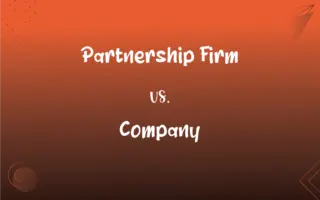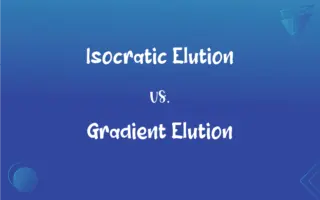Conditioned Stimulus vs. Unconditioned Stimulus: What's the Difference?
Edited by Aimie Carlson || By Harlon Moss || Published on February 15, 2024
Conditioned stimulus is a previously neutral stimulus that elicits a response after being associated with an unconditioned stimulus, which naturally and automatically triggers a response.

Key Differences
A conditioned stimulus (CS) is an initially neutral stimulus that, after being paired with an unconditioned stimulus (US), comes to elicit a specific response. The unconditioned stimulus, on the other hand, is naturally capable of triggering a response without prior conditioning.
The conditioned stimulus plays a central role in the learning process known as classical conditioning, where it acquires the ability to induce a conditioned response. The unconditioned stimulus inherently triggers an unconditioned response without any learning process.
In Pavlov's experiment, a bell tone (CS) became associated with food (US) and began to elicit salivation, a response originally only triggered by the food. The food is the unconditioned stimulus as it naturally caused salivation without any training.
The association between the conditioned stimulus and the unconditioned stimulus is formed through repeated pairings. In contrast, the unconditioned stimulus does not require any association or training to elicit a response.
The response to a conditioned stimulus is learned and may diminish over time if the stimulus is presented without the unconditioned stimulus. The response to an unconditioned stimulus is automatic and remains relatively stable over time.
ADVERTISEMENT
Comparison Chart
Nature
Initially neutral, becomes significant
Naturally and inherently significant
Role in Learning
Acquires ability to trigger a response
Naturally triggers a response
Example in Classical Conditioning
Bell in Pavlov's experiment
Food in Pavlov's experiment
Requirement for Association
Requires pairing with unconditioned stimulus
No pairing required
Response Elicited
Learned and can diminish without reinforcement
Automatic and consistent
ADVERTISEMENT
Conditioned Stimulus and Unconditioned Stimulus Definitions
Conditioned Stimulus
Initially Neutral.
The sound of a whistle before starting a race.
Unconditioned Stimulus
Inherent Response Trigger.
Loud noise startles a person.
Conditioned Stimulus
Pairing with Unconditioned Stimulus.
A specific song playing before a favorite TV show.
Unconditioned Stimulus
Directly Triggers Unconditioned Response.
A hot stove causes an immediate withdrawal reflex.
Conditioned Stimulus
Learned Significance.
Bell sound becomes associated with meal times.
Unconditioned Stimulus
Naturally Elicits Response.
The smell of food causes hunger.
Conditioned Stimulus
Elicits Conditioned Response.
A perfume smell reminds you of a specific person.
Unconditioned Stimulus
Consistent and Automatic.
Feeling cold when touching ice.
Conditioned Stimulus
Acquires Response Triggering Ability.
Flashing lights signal a test alarm.
Unconditioned Stimulus
Requires No Learning.
A sudden bright light causes blinking.
FAQs
Is a conditioned stimulus natural or learned?
It's a learned trigger.
Can any stimulus become a conditioned stimulus?
Yes, if properly paired with an unconditioned stimulus.
Does an unconditioned stimulus require training?
No, it works naturally.
Can an unconditioned stimulus change?
Generally, it remains consistent.
Is salivating to food a conditioned response?
No, it's an unconditioned response.
What is a conditioned stimulus?
A stimulus that elicits a response after conditioning.
How is a conditioned stimulus created?
Through association with an unconditioned stimulus.
Does a conditioned stimulus always work?
Its effectiveness can diminish without reinforcement.
What is an unconditioned stimulus?
A stimulus that naturally triggers a response.
Can a conditioned stimulus lose its effect?
Yes, through a process called extinction.
Is fear of a specific object a conditioned response?
Yes, if the fear is learned.
Can a conditioned stimulus create a strong response?
Yes, depending on the strength of the association.
Is hunger an unconditioned response?
Yes, when triggered by the smell or sight of food.
Can a conditioned stimulus be unlearned?
Yes, through processes like counterconditioning.
What's an example of a conditioned stimulus in advertising?
A brand jingle associated with happiness.
Are phobias examples of conditioned responses?
Often, they are learned responses to conditioned stimuli.
How long does it take to establish a conditioned stimulus?
It varies based on frequency and strength of pairings.
Does an unconditioned stimulus vary between individuals?
It's usually universal, but individual differences can exist.
Can conditioned and unconditioned stimuli be the same?
Theoretically yes, but they usually serve different roles.
Are all reflexes unconditioned responses?
Yes, reflexes are typically unconditioned responses.
About Author
Written by
Harlon MossHarlon is a seasoned quality moderator and accomplished content writer for Difference Wiki. An alumnus of the prestigious University of California, he earned his degree in Computer Science. Leveraging his academic background, Harlon brings a meticulous and informed perspective to his work, ensuring content accuracy and excellence.
Edited by
Aimie CarlsonAimie Carlson, holding a master's degree in English literature, is a fervent English language enthusiast. She lends her writing talents to Difference Wiki, a prominent website that specializes in comparisons, offering readers insightful analyses that both captivate and inform.
































































